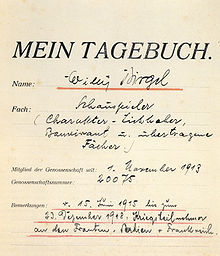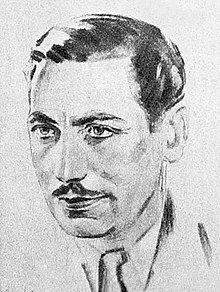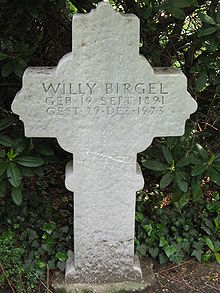Willy Birgel
Wilhelm Maria Birgel (born September 19, 1891 in Cologne , † December 29, 1973 in Dübendorf , Switzerland ) was a German actor .
Life
Willy Birgel was the son of a goldsmith working for Cologne Cathedral. As the oldest of six children, he was supposed to take over the father's company. According to his own testimony, he was very impressed by the mysticism of Catholicism, and under the influence of Maurice Maeterlinck's renaissance drama Monna Vanna , Birgel decided to pursue an acting career. Due to the resistance of his father, this did not happen immediately, and Birgel first attended the arts and crafts schools in Cologne and Düsseldorf. From 1912 to 1913 Birgel was a drama student at the theater in his hometown of Cologne, from 1913 to 1914 he was an acting trainee at the Bonn City Theater . His other stations were the Crystal Palace Dessau (1914), again the Stadttheater Bonn (1914–1915), Cologne (1915) and Koblenz (1916). During the First World War he served in the Balkans and on the Western Front from 1915 to 1918 and became a reserve officer. Birgel then continued his career at the Theater Aachen (1919–1924), most recently under Francesco Sioli . Together with Sioli, Birgel moved to the Nationaltheater Mannheim in 1924 , where he enjoyed great success until 1934 in roles such as Faust and Mephistopheles in Goethe's Faust I , Franz Moor in Schiller's Die Räuber and the title characters in Shakespeare's Hamlet and Richard III.
When Birgel got a supporting role in the film A man wants to Germany in 1934 at the age of 43 , it was not foreseeable that he would subsequently develop into a heartthrob and darling of the public. After portraying shady characters in films, his potential as a charming grand seigneur was discovered in 1937 . Against the background of the film engagements, Birgel moved to Marienbader Straße 1 in Berlin-Schmargendorf.
He had his first leading role in the film Prince Voronzeff . He played in entertainment films together with Zarah Leander , Gustaf Gründgens and Heinrich George , but also in propaganda films of the Nazi regime such as Enterprise Michael (1937), Feinde (1940) and Comrades (1941). Not least because of this, he was appointed state actor by Reich Propaganda Minister Joseph Goebbels in 1937 , and later included in the list of God- gifted people.
In 1941 Birgel played in the film … rides for Germany , directed by Arthur Maria Rabenalt, a captain who, by participating in the “Grand Prix of Europe”, restored “German honor” in the mood of the German defeat after the First World War. The film was given the rating of "particularly valuable in terms of state policy" by the film testing agency at the time . Because of her role in this film and other appearances in National Socialist propaganda films, the Allies imposed a temporary ban on Birgel after the Second World War.
In 1947 Birgel played in the film Between Yesterday and Tomorrow . In the 1950s he was one of the most famous film actors. Birgel's role type changed to the mature gentleman, the old-school charmer or that of the father figure.
After the unsuccessful attempt as a film director in 1955, Birgel turned to acting roles in the theater again. In 1961, in the role of doctor, he was part of the ensemble for the world premiere of Max Frisch's drama Andorra at the Schauspielhaus Zurich .
Birgel worked for television in the early 1960s. He made one of his last cinema films in 1965: As an aging hunting writer in Peter Schamoni's honeymoon for foxes , Birgel proved that he can deal with his image in a self-deprecating way.
Birgel was married twice. He died of heart failure in 1973 and was buried in the Melaten cemetery (lit. D) in the Lindenthal district of his native Cologne .
Filmography
- 1934: A man wants to go to Germany
- 1934: Prince Woronzeff
- 1935: Barcarole
- 1935: The girl Johanna
- 1935: One too many on board
- 1935: Black roses
- 1936: final chord
- 1936: traitor
- 1936: Riding to freedom
- 1937: People without a fatherland
- 1937: Michael company
- 1937: Fanny Elssler
- 1937: To new shores
- 1938: Faded melody
- 1938: secret sign LB 17
- 1938: The Deruga case
- 1938: The blue fox
- 1939: Hotel Sacher
- 1939: The governor
- 1939: Maria Ilona
- 1939: Congo Express
- 1940: enemies
- 1940: The Queen's Heart
- 1941: … rides for Germany
- 1941: comrades
- 1942: The dark day
- 1942: diesel
- 1943: You belong to me
- 1944: The Majorate Lord
- 1944: With my eyes / In the Temple of Venus
- 1944: I need you
- 1944: Music in Salzburg
- 1945: The Noltenius brothers
- 1947: between yesterday and tomorrow
- 1950: Hunted by the devil
- 1951: The Eternal Game
- 1951: When the evening bells ring
- 1952: You mustn't ask my heart
- 1952: Heidi
- 1953: The chaplain of San Lorenzo
- 1953: Stars over Colombo
- 1954: The Maharaja's Prisoner
- 1954: Consul Strotthoff
- 1954: Captain Vronsky
- 1955: a man forgets love
- 1955: Heidi and Peter
- 1955: The Isle of the Dead
- 1955: Rose Monday (also director)
- 1956: roses for Bettina
- 1956: Midsummer Night
- 1956: a heart returns home
- 1956: Between time and eternity
- 1956: The saint and her fool
- 1957: Family Schölermann (TV series)
- 1957: Gynecologist Dr. Bertram
- 1958: love can be like poison
- 1958: Girls with pretty legs ( Le belissime gambe di Sabrina )
- 1958: The priest and the girl
- 1959: beloved beast
- 1959: a passionate doctor
- 1959: When the bells ring brightly
- 1961: Mrs. Cheney's end
- 1962: Romance in Venice
- 1964: A coffin from Hong Kong
- 1964: Andorra
- 1966: Agent 505 - Beirut Death Trap
- 1966: Closed season for foxes
- 1967: The Chalk Garden (TV movie)
- 1968: The Meteor (TV movie)
- 1968: freckles
- 1969: The Fairy (TV movie)
- 1969: Isn't that all of us? (TV movie)
- 1971: Professor Sound and the Pill (TV movie)
- 1971: Glückspilze (TV movie)
Prizes and awards
- 1949: Schiller badge from the city of Mannheim
- 1960: Bambi
- 1964: Gold film tape
- 1966: Federal Film Prize : Filmband in Gold for many years of outstanding work in German film
- 1972: Grillparzer-Ring of the City of Vienna
literature
- Thomas Blubacher: Willy Birgel . In: Andreas Kotte (Ed.): Theater Lexikon der Schweiz . Volume 1, Chronos, Zurich 2005, ISBN 3-0340-0715-9 , p. 209.
- Frank Blum: An officer and a gentleman. Willy Birgel revisited. In: Film Mäg , 3 parts; No. 4-5 (double number, April 2009), pp. 20-25; No. 6 (Sept. 2009), pp. 115-125; No. 7 (April 2010), pp. 47-52. ISSN 2191-4400
- Wilhelm Hermann: Willy Birgel. Life and documents. Reiss-Museum, Mannheim 1987 (picture booklets of the Städtisches Reiss-Museum Mannheim No. 7)
- Eberhard Mertens (Ed.): Rides for Germany. A cross-section through a successful film in text and images. The Willy Birgel memory book. Olms, Hildesheim 1979 ISBN 3-487-08157-1
- HE Weinschenk: Actors tell stories. Wilhelm Limpert-Verlag, Berlin 1938, 41ff
Web links
- Literature by and about Willy Birgel in the catalog of the German National Library
- Willy Birgel in the Internet Movie Database (English)
- Willy Birgel at filmportal.de
- Christina Hoor: Willy Birgel. Tabular curriculum vitae in the LeMO ( DHM and HdG )
- Pictures by Willy Birgel In: Virtual History
Individual evidence
- ↑ Ernst Klee : Kulturlexikon zum Third Reich: Who was what before and after 1945 . 1st edition. S Fischer, Frankfurt am Main 2009, ISBN 978-3-596-17153-8 , pp. 49 .
- ^ The grave of Willy Birgel. knerger.de
- ^ Josef Abt, Johann Ralf Beines, Celia Körber-Leupold: Melaten - Cologne graves and history . Greven, Cologne 1997, ISBN 3-7743-0305-3 , p. 163.
| personal data | |
|---|---|
| SURNAME | Birgel, Willy |
| ALTERNATIVE NAMES | Birgel, Wilhelm Maria (real name) |
| BRIEF DESCRIPTION | German actor |
| DATE OF BIRTH | September 19, 1891 |
| PLACE OF BIRTH | Cologne , Germany |
| DATE OF DEATH | December 29, 1973 |
| Place of death | Dübendorf , Switzerland |



